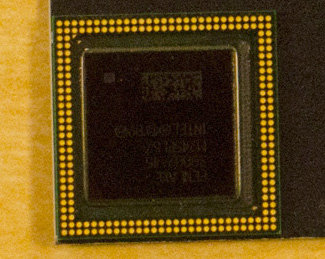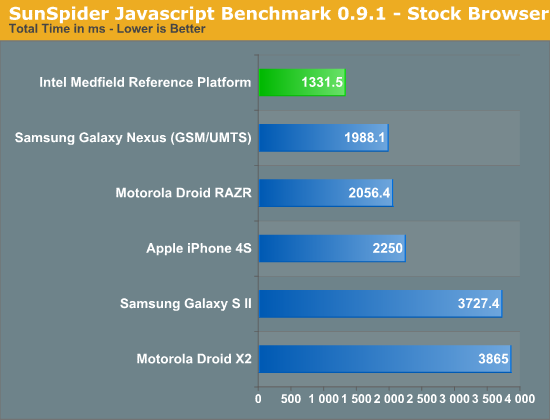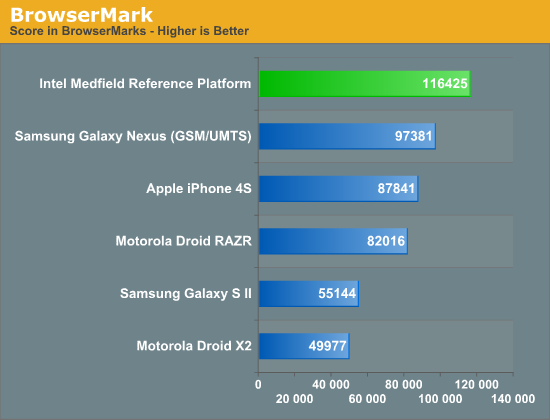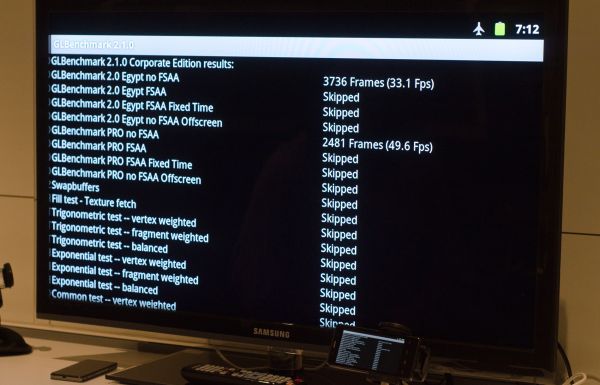Intel's Medfield & Atom Z2460 Arrive for Smartphones: It's Finally Here
by Anand Lal Shimpi on January 10, 2012 8:00 PM ESTIt's here. Intel's first smartphone SoC that you'll actually be able to buy in a device before the end of the year. The platform is called Medfield and Paul Otellini just announced its first device partners.
Medfield starts out as a bonafide mobile SoC. Whereas Moorestown was a "two-chip" solution, Medfield is just one - the Penwell SoC:

The SoC is only available in a PoP (Package on Package) configuration measuring 12mm x 12mm. Intel wouldn't give out a die size but it did show me a Penwell sample without the stacked DRAM:

Since I know the measurements of the package I could estimate the dimensions of the silicon itself. My math worked out to be around 62mm^2. That's larger than a Tegra 2-class SoC, but smaller than Tegra 3 or Apple's A5. The diagram of its high level architecture above helps explain why.
There's only a single version of Medfield being announced today: the Intel Atom Z2460. The Z2460 features a single Atom core with a 512KB L2 cache, a PowerVR SGX 540 GPU and a dual-channel LPDDR2 memory interface. In a world where talking about four Cortex A9s and PowerVR SGX 544MP2s isn't uncommon, Medfield starts out almost sounding a bit...tame. But then you see its performance:

Although running what appears to be a stock Gingerbread browser, Intel's Medfield reference platform posts SunSpider performance better than any other smartphone we've tested - including the Galaxy Nexus running Ice Cream Sandwich. Intel promises that Medfield's performance will scale on ICS as well - the gap should be maintained. We've seen high results from reference designs in the past, but the Medfield platform is a little different as you'll soon see - it's a complete smartphone design that should be representative of handsets that hit the market later this year.
Medfield isn't a one trick pony either, performance is similarly dominating under BrowserMark:

These are tablet-like scores. Here the Galaxy Nexus running ICS comes close, but once again Intel expects that on the same OS Medfield should be faster than any of the currently available SoCs.
I asked Intel where its SunSpider and BrowserMark performance advantages came from, especially considering we've typically only seen huge gains with new browsers and not new SoCs. Their response pointed to a bunch of factors, but one stand out issue was the A9 has a great execution core but seems to be more limited on the memory interface. Atom can support far more outstanding misses in L2 than the Cortex A9, which chokes bandwidth to the processor for anything not already in the L2 cache. This may be one of the reasons why we've never been able to get really high bandwidth numbers out of A9 based SoCs. It's probably safe to assume that things will be different with the Cortex A15, but for now it's little things like this that give Medfield a performance advantage.
GPU performance is understandably not as impressive. We couldn't get offscreen numbers of GLBenchmark 2.1 but we did get results at the device's native resolution (1024 x 600):
3D performance is better than the OMAP 4460 due to Medfield's 400MHz GPU clock compared to ~300MHz in most OMAP4 devices.
Performance without power considerations is meaningless, especially in the smartphone world. Luckily for Intel, Medfield seems very competitive there as well. Intel provided some power and performance data for Medfield based on its reference platform. I still haven't been able to verify any of this for myself, but I was able to see some power tests run in person on the reference platform and competitive devices.
The Intel provided values are pretty astonishing . Sub 20mW idle, sub 750mW during a call on 3G and although not pictured here, Intel's internal data suggests ~1W power consumption while browsing the web compared to ~1.3W on the iPhone 4S and Galaxy S 2. I've done my own measurements on 4S web browsing and came up with a very similar value.
| Intel Measured Smartphone Power Consumption (Identical Display Brightness) | ||||||
| Standby (3G) | Talk (3G) | Browsing (3G) | Video Playback 720p | |||
| Apple iPhone 4S | ~38mW | ~800mW | ~1.3W | ~500mW | ||
| Intel Medfield Reference | ~18mW | ~700mW | ~1.0W | ~850mW | ||
| Samsung Galaxy S II | ~19mW | ~675mW | ~1.2W | ~650mW | ||
The performance and power data both look great for Medfield. You would think that this data, assuming there's nothing fundamentally wrong, would be enough to convince a handset maker to actually give Intel a shot. You'd be right.
In addition to disclosing Medfield performance data, Intel is also announcing partnerships with both Motorola and Lenovo. The former is a broad, multi-year agreement stating that Motorola plans on creating many devices based on Intel silicon - the first of which will be a smartphone due out before the end of the year. Tablets will follow at some point as well.
Lenovo on the other hand will actually be taking and tweaking Intel's own Medfield reference platform, and releasing it in China in Q2.
All of this is exactly what Intel needed: a start.











164 Comments
View All Comments
Dribble - Thursday, January 12, 2012 - link
I see fudzilla managed to get a BenchmarkPi score:The HTC Thunderbolt (Snapdragon 1GHz): 888ms
Lenovo K800 (1.6Ghz Atom): 743ms
LG Optimus 2X (Tegra 2): 550ms
french toast - Thursday, January 12, 2012 - link
Yea when you get past the Intel marketing and start digging you find its not really thtat special when compared to last years designs. hers some more. Intel medfield 3791 quadrant. samsung galaxy note @1.4ghz 4300+http://www.youtube.com/watch?v=k2SzV_bl76k
If you level the clock speed and use the same software on the ARMs you would get better than this in cafeinemark;
http://androidandme.com/2012/01/news/intel-medfiel...
Add that to the other links i posted earlier, and do some multithreaded tests and the Atom doesn't look that impressive compared to duel core A9s on 40nm...let alone quad core kraits on 28nm...
dwade123 - Thursday, January 12, 2012 - link
Give a a few years and we 'll see Intel dominating this market.Targon - Thursday, January 12, 2012 - link
This is a single-core chip....in an environment that is already going to be dominated by dual-core chips by the time it is released. What is Intel trying to do, emulate Palm, who would announce something that sounds great, then a year later when product is actually shipping, seems pretty weak? Palm died as a result(even though it was under the HP umbrella at the end), and Intel is just following that example of what NOT to do.Intel may have process advantages, but Intel doesn't do much when it comes to real innovation.
happycamperjack - Thursday, January 12, 2012 - link
Judging from the BrowserMark and SunSpider, Medfield has tegra 3 beat for about 10% to 30% in a more single threaded application. But in a more threaded application such as photo editing apps, some games and also multitasking, Tegra 3 would come out on top. Not to mention Tegra 3 would probably do a lot better in battery life and 3D games as well.But backward compatibility for lower end Windows 8 tablets? Yes please!
Lucian Armasu - Friday, January 13, 2012 - link
A 10% performance different shouldn't be surprising, considering Intel Atom is running at 1.6 Ghz and Tegra 3's first core is running at 1.4 Ghz. This only means that a Cortex A9 core is about as powerful as Atom at the same clock speed. And by the time it's out it will have to compete with Cortex A15, which is twice as powerful as Cortex A9 for the same clock speed. Plus it will be dual core vs the single core Atom. Krait chips should be in the same ballpark as Cortex A15, perhaps a bit weaker, but still much more powerful than Atom.As for the compatibility with Windows 8. I don't understand what's the benefit of that? To use programs that are not optimized for touch? Why? If that was such a big deal, you could already use Windows 7 tablets. Whether Microsoft is pushing for ARM tablets, or x86 tablets, they still have to start from scratch, because they need apps that are fully optimized for touch, and not for the mouse. So in this case x86 has no advantage over ARM, at least not more than it already had in the Windows7-era. And if Microsoft were smart, they'd actually push the ARM tablets instead to compete on battery life.
happycamperjack - Friday, January 13, 2012 - link
You don't understand the benefit of backward compatibility?? Are you serious?? How about instant access to biggest libraries of applications ever while Windows 8 apps have time to mature.As for the performance of the chip, I was disappointed about Intel's SoC until I realize that it's actually running android 2.3. So it would be more fair to compare the performance against another Android 2.3, Galaxy S II, which benchmarked at half the speed of Intel! But it's GPU is definitely garbage.
thunng8 - Friday, January 13, 2012 - link
The Motorola RAZR is also running 2.3.french toast - Friday, January 13, 2012 - link
What has been misleading about the Intel pushed benchmarks in this article, is that although the Medfield runs Gingerbread, it also run a heavily updated varient.2.3.7..which according to the boys over at xda, has been optimised to near ICS levels..Note that the phones benchmarked against it run stock Gingerbread which can be noticebely slower on older versions.
Another thing to note, the phones benchmanrked against, also have heavy custom UI skins over the top..aka sense/touchwiz which saps power, hence why uses prefer to root their phone..for that very perforance enhanced reason.
-Where as the Medfield reference phone does not.
If you level all software equal, i very much doubt the Medfield would have a lead in any benchmark, and in some cases would likely lose, such as graphics, multhreaded, and battery use scenarios that stress the cpu.
That is against phones that have been on the market 18months or so by the time Medfield ships AND are lower clocked A9s.
CUEngineer - Friday, January 13, 2012 - link
You guys are hilarious... Obviously there will be an optimized OS version that google and intel worked on, since its using a different ISA then arm, they need to optimize the binaries to do things such as take advantage of instructions intel adds for performance which no ARM IP licenseee company is allowed to do... Any good company will optimize software to run on their hardware to give better results and that is valid...Intel has been doing high performance designs for many years now, ARM just designs their IP to work simple and without consuming much power, so it wouldnt be hard to think that intel analyzes certain performance features differently such as handling hits under misses and taking multiple miss requests without bottlenecking the system... an out of order CPU could make this impact less since other instructions might be able to be scheduled while waiting for the miss to be completed..
Either way all you folks should worry about is how close those power numbers because once intel gets in this space it is going to dominate, and will have attractive offerings since everyone else is basically using the same IP from arm with different wrappers...